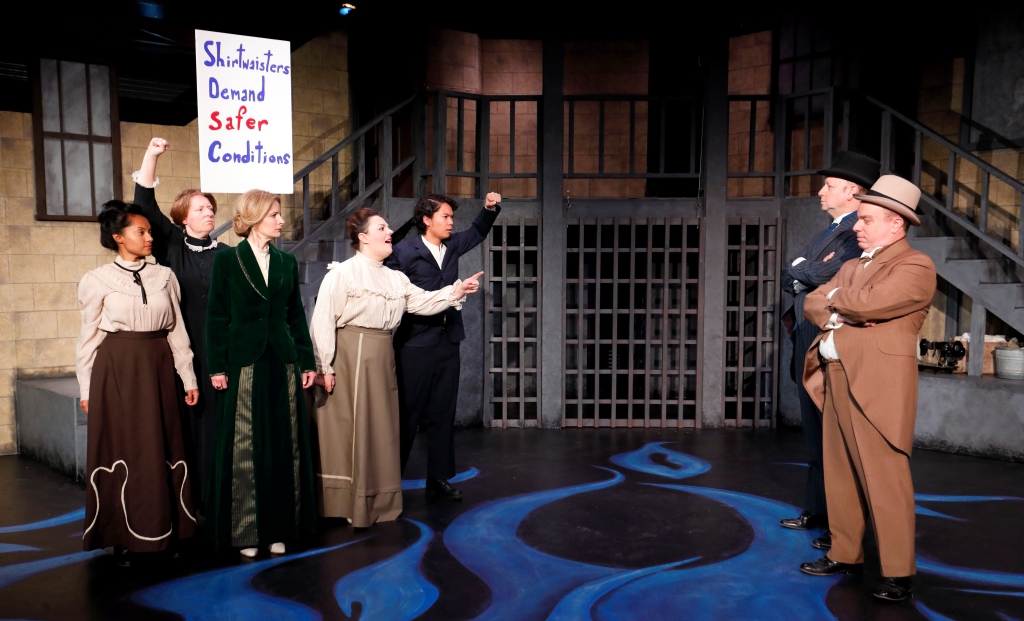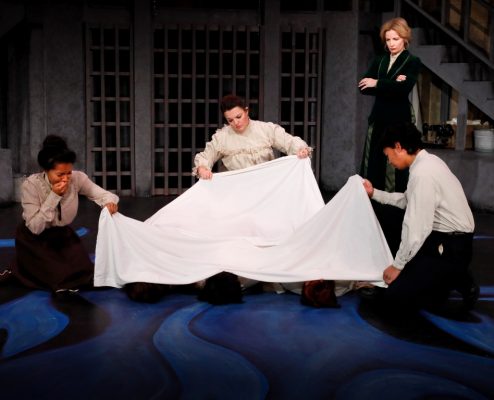Triangle Factory Fire Project a distressingly familiar tragedy
Posted on October 11, 2018 By Colin MacLean Entertainment, Front Slider, Theatre
 To launch its 60th season, Walterdale Theatre has chosen The Triangle Factory Fire Project, a highly dramatic retelling of the deadliest industrial disaster in New York’s history. Similar recent worldwide events have served to tear the Century-old disaster out of the dusty pages of newspapers and into a renewed currency. The play runs until Oct. 20.
To launch its 60th season, Walterdale Theatre has chosen The Triangle Factory Fire Project, a highly dramatic retelling of the deadliest industrial disaster in New York’s history. Similar recent worldwide events have served to tear the Century-old disaster out of the dusty pages of newspapers and into a renewed currency. The play runs until Oct. 20.
The massive fire in the Triangle Shirtwaist Factory in 1911 took just half an hour to snuff out the lives of 146 workers. Despite desperate efforts, flames swept through the eighth, ninth and tenth floors. Some panic-stricken workers did make it to the fire escape – many did not. The play creates dramatic account of the fire, and the public fallout in the aftermath.
The story has a distressingly familiar ring: Doors were locked to keep workers from stealing merchandise, terrified women leapt from high roofs because the ladders of the firetrucks couldn’t reach them, helpless spectators watched screaming women outlined by fire in windows above them. Some perished in elevator wells. Many were engulfed in flame. Most of those who died were poor – Jews and Italians mostly, working long hours for little pay. Ages of the victims ranged from young teens to the elderly.
 Director Barbara Mah’s sturdy Walterdale production endeavours to locate the humanity behind the terrible event, and in doing so turns out to be a rather intriguing piece of theatre. Using some clever storytelling devices, the director moves things along briskly, using 20 actors to portray many characters, employing headlines from the time to frame her scenes in a realistic manner. We see the nascent labour and suffragette movements of the time. The technique and staging serves to bring the harrowing stories heard in the courtroom into an effective dramatic relief.
Director Barbara Mah’s sturdy Walterdale production endeavours to locate the humanity behind the terrible event, and in doing so turns out to be a rather intriguing piece of theatre. Using some clever storytelling devices, the director moves things along briskly, using 20 actors to portray many characters, employing headlines from the time to frame her scenes in a realistic manner. We see the nascent labour and suffragette movements of the time. The technique and staging serves to bring the harrowing stories heard in the courtroom into an effective dramatic relief.
The first half of the play gives us a series of sharply focused portraits of the lives of some of the victims. They tell of the terrible events of the fire. The second half traces the public grief, accusations, self-serving lies, indignant prosecutors and final financial settlements.
One might wish for a bit more human exposition of the characters in the original writing – perhaps some sense of the vibrancy, even humour, in their lives. The play never goes far beyond what you might read in newspaper reports or government investigations. But Mah has cast well and her actors strive to flesh out the lives of anonymous people who otherwise might be forever forgotten. In fact, the company is so universally committed to the play and their roles that picking out any individual would do a disservice to the considerable group impact.
Walterdale lacks the technical proficiency of some other local companies but they sure put a lot of ingenious creativity into this play. Leland Stelck’s simple but functional multi-level set features staircases, an (apparently) working elevator, doorways and a courtroom. Kari McQueen is credited as Multimedia Operator and, with the assistance of Lighting Designer Brad Melrose, creates a conflagration of impressive proportions. Mah, using smoke and flickering lights, orchestrates the fire itself with a growing terror rising to horror as, one after the other, people are dying before our eyes. There are moments where you may wish to look away.
Mah propels her actors around the stage, filling it with movement. In the first spectacular scene the actors all mime the mechanical moves of the “girls” operating the machines. The accelerated pace brings a sense of the bustle of a burgeoning metropolis bursting beyond its boundaries. The building would be a babble of languages and accents but Mah wisely directs the actors to speak in their own voices.
The play leaves you with a prevailing sense of sadness at the loss of so many lives and the never-ending repetition of something that seems to have become an appalling ritual. Some rules did change after the tragedy, and this commendable, sober and powerful play ends on a hopeful note.













